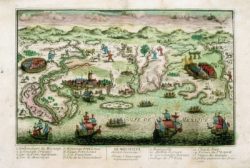Spring 2018
They Built This City
New exhibition and book examine early New Orleans and it's people
Published: March 8, 2018
Last Updated: October 5, 2018
“Just look at that street grid,” observed Priscilla Lawrence, poring over a brightly tinted map from 1732. “We’re still walking those same streets today.”
The centuries-old document captivating Lawrence, Executive Director of The Historic New Orleans Collection (THNOC)—a detailed city plan by French engineer Ignace-François Broutin, on loan from the Archives nationales d’outre-mer in Aix-en-Provence, France—is one of nearly eighty artifacts linking past to present in New Orleans, the Founding Era, on view this February and accompanied by a bilingual, book-length catalog. A kickoff to THNOC’s yearlong celebration of the city’s tricentennial, this special exhibition will occupy two floors of the Royal Street campus, including the Louisiana History Galleries. Loans from twenty public and private collections across France, Spain, Canada, and the United States complement THNOC’s own celebrated holdings from the French colonial era.
Broutin’s map anchors a section of the exhibition dedicated to urban planning. The fledgling city takes shape in an array of French sketches, surveys, and architectural drawings, each an attempt to inscribe order upon the colonial landscape. The earliest plan of New Orleans, dated circa 1718 and shaped like a pineapple, is credited to the ill-fated engineer Paul de Perrier, who died before reaching Louisiana. A less edible-looking plan from 1722 shows the French Quarter’s familiar rectilinear grid firmly in place. And in a 1726 watercolor panorama by Jean-Pierre Lassus, the earliest known painter to work in New Orleans, the grid gains a human presence, seen in the bustling activity along the riverbank.
Lassus’s Veüe et perspective de la Nouvelle Orléans is a pastoral idyll, an Enlightenment-era paean to humankind’s capacity to tame nature. Just eight years old, the city appears orderly and prosperous. Now take a closer look. The figure in the foreground, battling an alligator, is an enslaved laborer. So, too, are the men chopping wood, carrying timber. Priceless for its artistry, the Lassus watercolor is prescient in its social commentary. The viability of New Orleans was premised on the availability of enslaved and conscripted labor; the French street grid was inscribed not upon virgin land but upon a long-established Native settlement.

Plan de la Nouvell Orleans Capitale de la Louisiane. Courtesy of the Historic New Orleans Collection.
As conceived by exhibition curator Erin M. Greenwald, New Orleans, the Founding Era celebrates the diversity of the city’s early settlers, emphasizing the lived experiences of enslaved Africans, Natchez and Nodena Indians, Capuchin missionaries and Ursuline nuns, Canadian migrants, French- and German-speaking conscripts, soldiers, and scientists.
A number of items, such as a pair of eighteenth-century Native American bear-paw moccasins from the Musée du quai Branly in Paris and pieces of fifteenth-century Mississippian pottery from the University of Mississippi, have rarely traveled beyond their home institutions. “We hope that the power of seeing these amazing original items in the exhibition, whether paintings, documents, maps, or three-dimensional objects, will give every visitor a sense of awe and inspiration that they are viewing things that are nearly as old as the city itself,” Lawrence said.
New Orleans, the Founding Era
La Nouvelle-Orléans,
Les AnnésFondatrices
Published by The Historic New Orleans Collection
Hardcover • 176 pp. • 8.25″ x 10.25″
70 color images • $50.00;
available now at The Shop at The Collection
or online retailer
The generous support of lead sponsor Whitney Bank and an enthusiastic lineup of additional sponsors—2018 NOLA Foundation, Air Liquide, Alliance Française de La Nouvelle-Orléans, Les Causeries du Lundi, Conseil des Sociétés Françaises, French American Chamber of Commerce, France-Louisiane Franco-Américanie, the French Embassy, IberiaBank, Phillip Mollère, E. Alexandra Stafford, and L’Union Française—has enabled THNOC to supplement the gallery display with a dual-language exhibition catalog. Published in French and English, the book features contextual essays by eight leading scholars of the French Atlantic World, along with an illustrated checklist. A foreword by Gérard Araud, ambassador of France to the United States, salutes the vitality “of the complex Creole society that was born from the city’s diverse peoples.”
Many thanks go to Grégor Trumel, former Consul General of France in New Orleans, who connected THNOC to Ambassador Araud and to the New Orleans French community. Trumel also recommended Henry Colomer, a French documentarian whose artful, respectful translation will bring New Orleans, the Founding Era to audiences worldwide. “Translation implies a close attention to detail,” explained Colomer, “as if you were making your way through a thick underbrush. The reward—the ultimate goal—is to reach higher ground and behold the wide and (hopefully) harmonious prospect you have been exploring step by step. In that sense, translating New Orleans, the Founding Era was a kind of ideal experience.”


